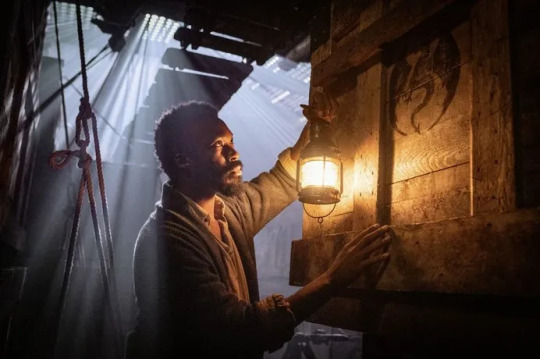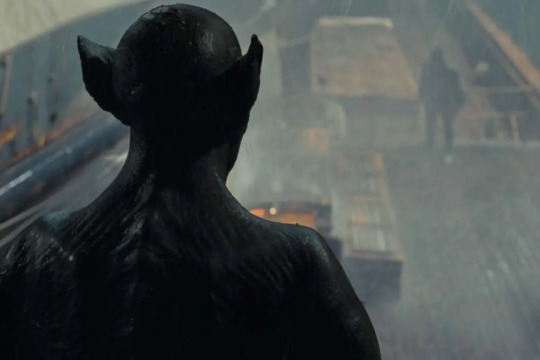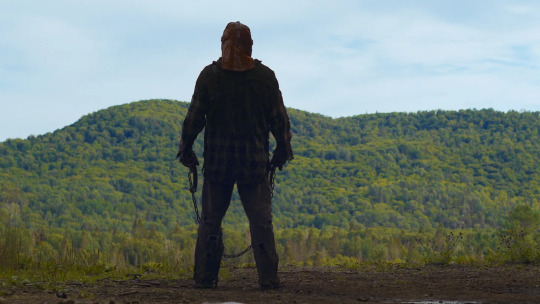Text
The Last Voyage of the Demeter
A crew worthy of a story.
(This article can also be found on my substack).
Adapting Dracula is not something that has ever been done seamlessly. In the 127 years since it’s publication, in what is likely hundreds of adaptations and retellings between stage plays, films, and novels, there is no adaptation that has truly followed the story from beginning to end. There are many reasons for this, as what worked in a novel in 1897 may not work in a modern day film, but adapting the full story is never what The Last Voyage of the Demeter set out to do, anyway. They are adapting a single chapter.
The Last Voyage of the Demeter is just what it says in the title: it is the story of the ship Demeter as it carries cargo from Carpathia to London, and in the process, becomes a nightmare for the crewmen on board. It chiefly follows Corey Hawkins in the role of Clemens, a doctor who joined the ship at the start of the journey and quickly becomes caught in the middle of the struggle to come.

One of the most difficult parts of telling a story that is, from the start, open about the fact that there are no survivors, is that you still want the audience to care for your cast. You want the deaths to hit despite the fact that they are already being braced for. And in this respect, the film succeeds. All it takes is a strong cast and a solid script for them to work from. The aforementioned Corey Hawkins shines in his role as the ship’s doctor and a man of reason, struggling to reconcile the evidence of the supernatural with the logic he’s holds tight to. Other standout performances come from David Dastmalchian as Wojchek, the ship’s first mate who attempts to maintain order throughout the voyage, and Woody Norman in the role of Toby, the captain’s grandson and the only child aboard the Demeter.
Each member of the Demeter’s crew may fulfill a familiar archetype, be it from the horror genre in general or in other stories of seafaring men, but ultimately, the performances by this cast round them out into something that feels much more real. There is a sense that these men have worked together for a very long time, and that there is more to their lives than this single voyage. And then you begin to watch as they get picked off, one by one.
The films more solid scares are when they play more intimately with this cast. Stuck on a tight ship, isolated on a stormy sea, there is plenty of opportunity to create an environment that feels claustrophobic. Though these are not always taken, there are still wonderfully dreadful moments awaiting the viewer. Some of the best even happen in the light of day.

Where this film thrives the most, however, is in it’s sound design. That should come as no surprise when you begin with a score composed by Bear McCreary, who is responsible for, among others, the award-winning scores for the video games God of War and God of War Ragnarok, the title theme to Black Sails, and the score to 2019’s Godzilla: King of Monsters. Intense, full of thematic strings and playing often with the feeling of being on a creaking ship out at sea, this film could not have asked for a better backing to tie it together.
And the score isn’t where the sound design ends, either. The attention of detail paid to the acoustics of the ship, from the way the storage hold is home to quiet echos to the way ever-present sea sloshes against the ship, comes together to create a deeply immersive atmosphere. A gimmick introduced early on in the film even plays with sound; Toby, while cheerfully giving a tour to the ship’s new doctor, tells him that he can knock on the hold at any time to communicate with other crew across the ship. One of the highlights of seeing this film when it was screening in theaters was being able to hear this knock echo, front to back, all the way down the ship, and knowing it would return to haunt us.

One common complaint from audiences of modern horror are that the films are, visually, too dark. In a way that fails to create atmosphere and instead hinders the viewing experience, creating an image that can hardly be parsed. This is not a complaint that could be found with The Last Voyage of the Demeter. Light and shadow are constantly at play through this film, found largely in the stark differences between the warm safety of lamplight and the cold, blue-tinted darkness at it’s edges. These contrasts often create something beautiful, even when there is danger lurking in the dark.
Stepping into the role of that danger is Javier Botet. Dracula is far from the first time that Botet has been the movie monster; from The Conjuring 2’s Crooked Man to some of the ghosts of Crimson Peak, he is no stranger to playing the supernatural. Dracula, in this film, takes a more animalistic approach. He is a creature that is desperate, and hungry, and has little time to toy with his food. It would seem he does retain some of his personality in the way he lures in or taunts his victims, which are the highlight moments of his kills.

The Last Voyage of the Demeter is, overall, an adaptation worthy of the haunting chapter of Dracula that it takes the bones of it’s story from. Clemens is a character that feels as if he could have been a part of the Dracula canon from the start, and the story he belongs to no less so. With a powerful score and a strong core cast, the Demeter’s final trip is a voyage worth taking, especially on a stormy afternoon.
#r;horror#r;2020s#unreeled#film review#movie review#the last voyage of the demeter#tlvod#dracula#I'm still working on the let the right on in / let me in review! just wanted to do something quick since its taking a minute
6 notes
·
View notes
Text
The DVD cannot die because the commentary track cannot die. Just btw. If we ever let the commentary track die ill start killing
3 notes
·
View notes
Text
In a Violent Nature
And the Deep Breaths Between Horrors.
(This article can also be found on my Substack).

It happens a number of times within the film. Facing a choice or a disappointment, Johnny’s shoulders rise and fall in the act of taking a single deep, distinct breath. Then he’ll move, towards the next goal or the sound of muffled voices off in the woods, with a slow gait and little sense of urgency. It’s as if he knows it’s a long walk, but that he’ll get there eventually. Watching the film, you take that walk with him. If there was ever a horror movie to give you time to breathe, In a Violent Nature is it. Set in a remote, woody area of northern Ontario, it’s the story of a group of teens who remove a locket from a rotting fire tower and re-awake the violent entity that it was keeping dormant. And this time, the camera is solely focused on the undead monster that claws itself out of the earth to track them down and slaughter them.
There’s a certain kind of bravery in making a slasher film that takes its time to move from one stunt to the next, as the classic slasher fan may find themselves bored by the long periods of time spent engrossed in the simple wild. And it’s brave to make a contemplative, slow-burn horror film into a slasher, as the arthouse fan might find the premise too simple. A fan of both, or someone who walks into the theater simply knowing what to expect, will find something clever, thoughtful, and eerie. One standout element of the film is found in its sense of choreography; despite a lack of musical score, there is a rhythm to the entire film. Johnny’s heavy, lumbering steps. The repeated swing of an ax, the perfect way in which the characters move around each other in order to catch or miss a glimpse of one another. Some of its best moments are when you realize that you- and Johnny- can see the next victim up ahead, but they remain oblivious.
In many ways, this film is a spectacle. Shot with a 3:4 aspect ratio and making full use of the Canon EOS C70’s Super 35mm Sensor, In A Violent Nature couldn't be more gorgeous. For a horror film, there is no shying away from daylight or color. Every detail of the landscape found in northern Ontario is laid out for the viewer to take in, from the distant, rolling mountains to the bright greens and yellows of the forest itself. Night time scenes are shot with minimal lighting gear, as the crew attempted to minimize what they would need to move through the location, which creates perfectly stark contrasts between bonfires, porch lights, and the inky darkness of the woods beyond. You are always immersed in this place. Of the look of the film, director Chris Nash says they wanted to create an environment “where you almost feel the threat of being alone in the woods by itself, without a big, old monster man with an axe hunting you down.”
This effect is honed in on in the lack of a musical score. The only thing you hear in the film is what Johnny hears. The crunch and brush of leaves, the flow of water, the whistle of birds. The revving of a truck, the distant argument between the cast of survivors, and muffled music coming from the radio inside their cabin. Or, of course, the crunch of bone.
Word-of-mouth says that in the screenings of this film, audience members vomited from the gore. It’s an age-old rumor that accompanies any film with a body count, but it might be understandable, if true. With a director like Nash- who has a slightly longer history in special effects than he does directing- the film could only turn out adequately gory. The kills are brutal, disgusting, sometimes absurd, and a fantastic time all the way through. Anyone with an appreciation for the practical side of gory special effects will get a kick out of the moments that Johnny settles on a weapon and gets to work.

The other joy of In a Violent Nature is in its performances. Caught only through brief glimpses of stories around the campfire or conversations out on a dock, the core cast of survivors (played by Andrea Pavlovic, Cameron Love, Liam Leone, Lea Rose Sebastianis, Alexander Oliver, Charlotte Creaghan, and Sam Roulston) share an incredible chemistry that instantly gives a sense of their relationships and their corresponding parts to play in the slasher narrative. The roles filled by Timothy Paul McCarthy, Lauren-Marie Taylor, and Reese Presley are no less fantastic when they step onto the scene, conveniently looking elsewhere until it’s their time to face down Johnny.

And speaking of Johnny, Ry Barrett never says a word in the role, but never does the character fall flat. There are sparks of personality hidden underneath his mannerisms, from the things that catch his curiosity to the casual way he slings an ax. The way he carries himself is both imposing and perfectly natural-- for him, if not for anyone else. Barrett was recast in the role after the previous star had to step back, and a large chunk of the film had to be reshot. Nash states in an interview for Points of Reviews that there was an initial belief that, because the character is in costume and rarely viewed from an onwards angle, that some of these shots could be worked together, but that wasn’t wholly the case. He says, “There are so many things with the performance that are important, in just how they carry themselves, the gait of their walk, just the weight of their footfalls.” That importance shows through in the final cut of the film, which is a phenomenal piece of performance on the part of Barrett.
In a Violent Nature is, in many ways, exactly what it calls itself. The concept of a slasher film from the slasher’s point of view might be a simple one, but in its execution, it becomes a standout piece of filmmaking. The care put into every second of its runtime shows through in a viewing experience that will leave you looking a little closer at the woods you drive through on your way home from the theater; partly because they’re beautiful, and partly because you never know what they could hide.
-
Some articles referenced in this review (that I recommend reading!):
In a Violent Nature Film Review (with Director Chris Nash)
Sundance: DP Pierce Derks on In a Violent Nature
Sundance Slasher In a Violent Nature puts Northern Ontario Front and Center
57 notes
·
View notes
Text
I really like movies
And I want to talk about them.
I'm Quentin! I've loved movies and filmmaking for as long as I can remember. So much so that it's what I went to college for and entertainment is the industry I've primarily belonged to. My favorite place to work is directly behind the camera.
It takes a lot to make a film; time, money, and other people and all of their time and money. We don't spend all that effort for nothing, and as a result, no matter the cheesy special effects or corny dialogue or ill-timed jokes, I think almost every film has something to love within it. That's what I'm here to explore.
Unreeled is a film review / discussion blog from yours truly, someone who just cannot shut up about movies. (You can find me on substack to subscribe to the email newsletter!)
I'm usually found over at @aidenwaites.
All reviews are tagged by genre and decade of release, and you can find them all in the tags of this post. They will be added to as they're created.
Thanks for stopping by!
1 note
·
View note